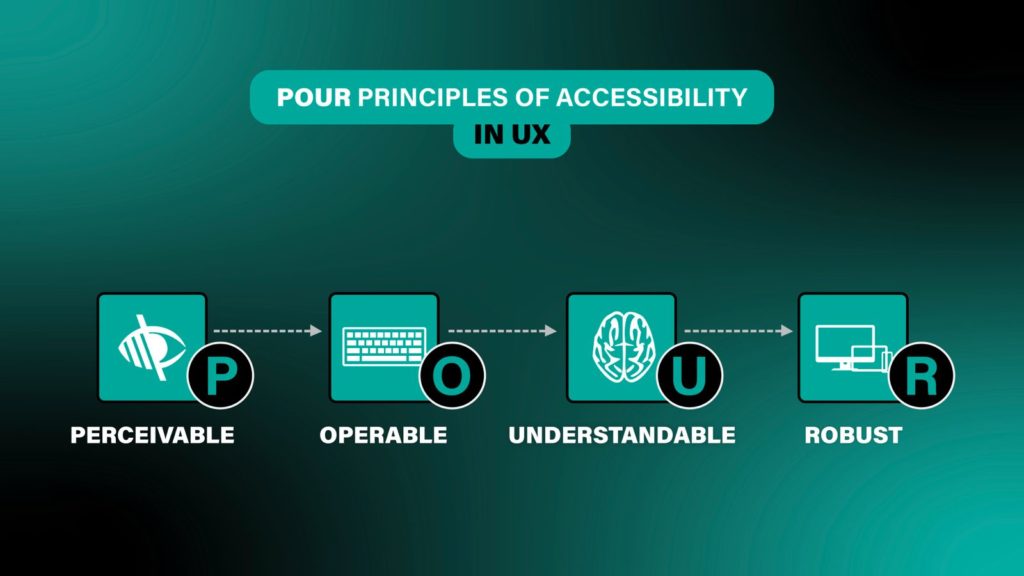Why Accessibility in UX Matters
Imagine a digital world where everyone can interact with your app or website without obstacles, regardless of their abilities. This isn’t a utopian fantasy; it’s the power of Accessibility in UX. By creating inclusive digital experiences, you empower everyone to engage with your brand and participate in the online world.
Reaching a Broader Audience: The Untapped Potential
Millions of potential users are currently missing out on your brand story because of accessibility barriers. Think about users with visual impairments who struggle with poor color contrast or those with motor limitations who can’t navigate complex menus. By neglecting accessibility, you’re essentially turning away a vast and diverse audience. This isn’t just a missed opportunity for growth; it can also be a legal issue, as many regions have regulations regarding website and app accessibility.
For example, the European Union (EU): The European Web Accessibility Directive (WCAG) requires websites and mobile apps of public sector bodies to be accessible to people with disabilities. While not all EU countries have specific laws on accessibility, WCAG serves as a guideline and can be referenced in lawsuits.
Accessibility opens the door for users with:
- Visual impairments: Clear color contrast, proper text size, and alternative text descriptions for images ensure everyone can access information.
- Motor limitations: Keyboard navigation, voice control options, and touch-friendly interfaces allow users with limited dexterity to interact seamlessly.
- Auditory impairments: Closed captions for videos, transcripts for audio content, and visual alerts provide alternative ways to engage with information.
- Cognitive differences: Clear and concise language, predictable layouts, and assistive technologies compatibility make your content easier to understand and navigate.
Beyond Compliance: The Benefits of Inclusive Design
Accessibility in UX goes beyond just ticking a compliance box (although that’s important too!). Here are the additional benefits you can expect:
- Enhanced User Experience for Everyone: Clear navigation, proper color contrast, and keyboard navigation aren’t just for users with disabilities – they improve the overall user experience for everyone. Think of it as designing for the broadest possible audience, ensuring a smooth and enjoyable experience for all.
- Improved Search Engine Ranking (SEO): Search engines like Google favor websites that are mobile-friendly and accessible. By implementing accessibility best practices, you can give your website a significant ranking boost, leading to increased organic traffic and improved online visibility.
- Building Brand Reputation: By prioritizing accessibility, you demonstrate your commitment to inclusivity and social responsibility. This fosters a positive brand image and positions your company as one that cares about all its potential customers.

Accessibility: Inclusive design, towards a better experience for all.
The Core Principles of Accessibility: Building a Strong Foundation (POUR)
Accessibility in UX rests on four core principles, known as POUR:
- Perceivable: Information and user interface (UI) elements must be presented in ways users can perceive. This includes providing alternatives for non-text content, such as alt text for images and captions for videos.
- Operable: User interface components and navigation must be operable. This means ensuring users can interact with your product using a variety of input methods, such as a keyboard, mouse, or touchscreen.
- Understandable: Information and the operation of the user interface must be understandable. This involves using clear and concise language, avoiding jargon, and providing clear instructions.
- Robust: Content must be robust enough to be compatible with a wide range of assistive technologies, such as screen readers and screen magnifiers.

POUR
Taking Action: Championing Accessibility
There are many resources available to help you integrate Accessibility best practices into your design and development process. Here are a few steps you can take:
- Educate Yourself: Familiarize yourself with WCAG (Web Content Accessibility Guidelines) – the international standards for web accessibility. Numerous resources online and from organizations like the W3C (World Wide Web Consortium) can guide you.
- Integrate Accessibility from the Start: Make accessibility a core principle from the very beginning of your design and development process. This ensures a more seamless and cost-effective approach.
- Test with Diverse Audiences: Include users with disabilities in your user testing process to gain valuable insights and ensure an inclusive user experience.
The Future of UX is Inclusive
By prioritizing Accessibility in UX, you’re not just creating a website or app; you’re creating a powerful tool that can reach a wider audience, foster inclusion, and establish your brand as a leader in digital accessibility.

12 comments
cheap enclomiphene saturday delivery cod
August 17, 2025 at 8:22 amget enclomiphene generic cheap
buy enclomiphene cheap generic uk
kamagra livraison de livraison le lendemain
August 17, 2025 at 9:22 amsans ordonnance kamagra france achat de
femme canadienne kamagra
no prescription cod androxal
August 17, 2025 at 10:59 amordering androxal canada purchase
cheap androxal cheap canadian pharmacy
get flexeril cyclobenzaprine generic in canada
August 17, 2025 at 12:34 pmBuy flexeril cyclobenzaprine tablets without a perscription
ordering flexeril cyclobenzaprine non prescription online
buy gabapentin and cealis online from canada
August 17, 2025 at 2:00 pmbuy gabapentin australia pharmacy
buying gabapentin overnight delivery
purchase fildena cheap fast shipping
August 17, 2025 at 2:06 pmbuying fildena generic in us
online order fildena generic no prescription
cheap itraconazole france where to buy
August 17, 2025 at 4:12 pmitraconazole australia generic online
buying itraconazole australia cheap
buy staxyn australia discount
August 18, 2025 at 3:03 amonline order staxyn cost on prescription
how to buy staxyn generic side effect
how to order avodart usa buy online
August 18, 2025 at 3:37 amcheap avodart purchase online from india
cheapest buy avodart cheap no prescription
how to buy xifaxan generic new zealand
August 18, 2025 at 5:29 ambuying xifaxan generic online canada
cheap xifaxan purchase online from canada
rifaximin no r x foreign
August 18, 2025 at 6:21 amonline order rifaximin canada price
cheap rifaximin cheap canada
je tam generický lék pro kamagra
August 18, 2025 at 8:55 amkanadská lékárna kamagra tablety 100 mg
kamagra s doručením v sobotu
Comments are closed.